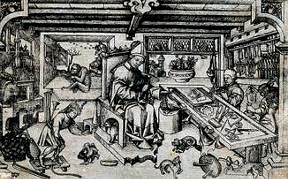
Artists have often made their patrons the subjects of their work.
Examples:
Vincent van Gogh (Dutch, 1853-1890), Portrait of Dr. Paul Gachet (1828-1909), June 1890 (Auvers-sur-Oise), oil on canvas, 26 x 22 1/2 inches (66 x 57 cm), private collection, NY, F 753. Dr. Gachet was a physician who specialized in homeopathy and psychiatry. He was a consistently helpful and generous patron and friend to numerous artists. On the recommendation of Pissarro, Gachet took van Gogh into his house in 1890. See bad-debt art and Post-Impressionism.

Edvard Munch (Norwegian, 1863-1944), Count
Harry Kessler, 1906, oil
on canvas, Neue Nationalgalerie,
Berlin. Harry Kessler was a German patron
of avant-garde art
and design
who died in 1937. See portrait.
When museum officials speak of
patrons, they are referring to the people who support their institutions
with donations of money
and/or works of art.
Various gods and saints have been considered patrons of various professions. Examples:
![]()
Johan Gregor van der Schardt (Dutch, 1530-
about 1580), Mercury, Bologna, Italy, 1570-1580, bronze, height 45 1/4 inches (115
cm), J. Paul Getty Museum, Malibu, CA. In Greek and Roman mythology
Mercury was messenger to Jupiter and served as patron of travel,
commerce, science, and thievery. Van der Schardt has given Mercury
several attributes that
signify his speediness: his sandals and hat sprout wings. The
caduceus he carries remind
us of Mercury's role as patron of science.

Master of Balaam (Dutch), St. Eligius in His Studio, c. 1450, engraving on paper, 11.5 x 18.5 cm, Rijksmuseum, Netherlands. St. Eligius, patron saint of blacksmiths, jewelers, and metal workers is working in a metalsmiths workshop. "He is hammering a goblet into shape on his anvil. Three other people are working in the studio: a master smith and two apprentices. The table is covered with tools. On the right, hammers, tongs and files hang in orderly rows against the wall. On the left is the furnace.... St. Eligius (c. 590-660) was born near Limoges (in modern France). Despite his humble beginnings he succeeded in becoming a goldsmith at the Frankish court. He entered the clergy and was later appointed Bishop of Noyon around 641."
In Roman Catholic tradition, the patron saints of arts and
education related occupations:
| Saint | Patron of |
| Angelico | artists |
| Bernadino of Siena | advertisers |
| Cecelia | musicians, poets, singers |
| David | poets |
| Eligius | blacksmiths, jewelers, metalworkers |
| Gregory | singers |
| Gregory the Great | musicians, teachers |
| James | laborers |
| John Baptist de la Salle | teachers |
| John of God | printers |
| Louis | sculptors |
| Lucy | glassworkers, writers |
| Luke | artists — painters, sculptors, glassworkers |
| Thomas (Apostle) | architects, builders |
| Thomas Aquinas | philosophers, scholars, students |
| Vitus | actors, comedians, dancers |
| Zita | scholars |
Also see collection, deaccession, donation, loan, muses, museum, and patronage.
https://inform.quest/_art